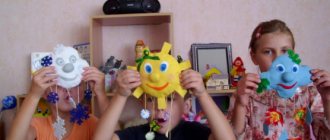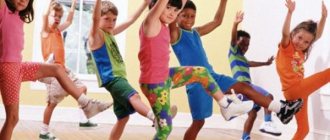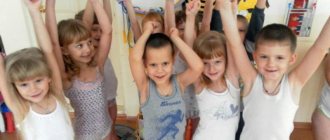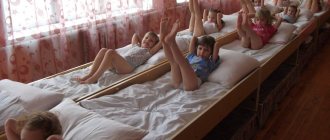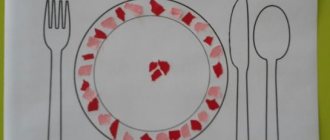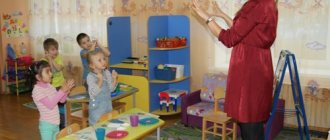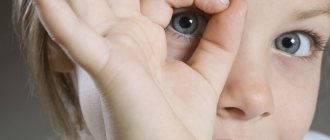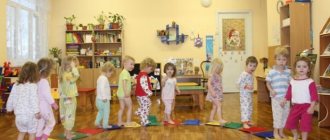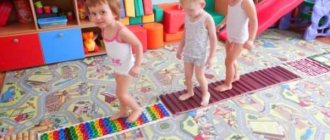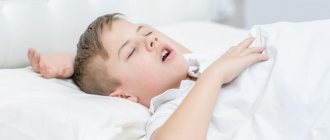Sleep plays a vital role in a child's daily routine. How the baby wakes up depends on his mood, state of health and how he will spend the rest of the day. In kindergarten, organizing a proper awakening is more difficult than for parents at home, because it is necessary for 15, 20, or even 30 people to throw off the shackles of Morpheus almost simultaneously, and to do it correctly. Solving such a problem is not easy, but with knowledge of some methodological nuances it is quite possible.
- 2 Types of gymnastics, or a little about the terms
2.1 Types of exercises
- 4.1 Table: card index of exercises after sleep
4.2.1 Video: gymnastics after waking up (middle group)
- 5.1 Table: sample analysis scheme
Goals, objectives and techniques
Gymnastics after sleep is a set of exercises that provide a smooth transition from calmness to wakefulness.
The objectives of such classes are:
- increase in muscle tone;
- improved mood;
- prevention of colds;
- strengthening the respiratory system;
- preventing the development of problems with posture, flat feet;
- fostering the habit of stretching the body after waking up.
Not only his mood, but also the emotional atmosphere of the entire group depends on how each child wakes up.
To achieve the goals, every day the teacher selects exercises to solve problems such as:
- toning the nervous system (that is, preventing irritability and anxiety that may arise after waking up);
- improving the functioning of the body’s main systems (cardiovascular, respiratory, as well as stabilizing the body’s protective functions);
- creating a positive atmosphere in the group.
All this is possible with the right combination of gymnastics techniques after sleep.
- The plot of the awakening. This technique is especially important for children of the first and second junior groups. The essence of the technique is that all exercises are carried out within the framework of a common plot. For example, a bear came to visit us and asked for help: her son Mishka could not wake up, and he needed to go to help his mother to pick raspberries for the winter - he needed to show by example how to quickly restore the body after sleep. In addition, it will be more interesting for children to perform certain actions accompanied by rhymes and short sayings.
- Musicality. Quiet, relaxing music, played a little louder than before bed, helps children of any age recover.
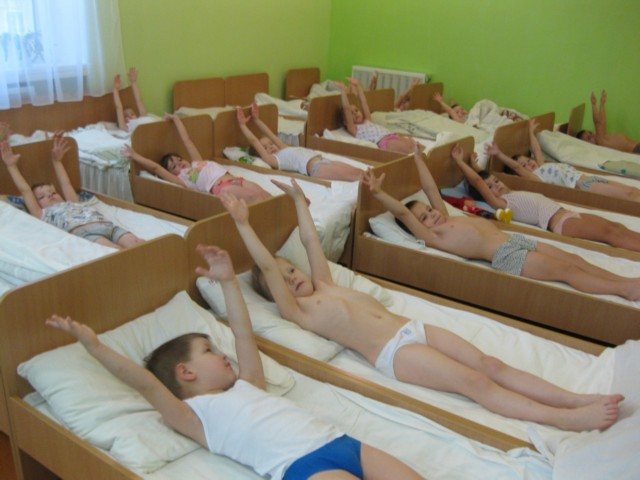
Gymnastics after waking up should be done to music
- Lying exercises. These complexes help to gradually restore muscle tone and move on to more active actions. Again, for children, more attention is paid to this block of exercises, since the younger the children, the more difficult it is for them to adapt to active activity after sleep.
- Active block of gymnastics (or “mat exercises”). It includes tasks that are performed while standing. The complex includes swinging arms, legs, body turns, squats, walking on massage mats, etc. For children in older groups, tasks such as complexes play a very important role in developing correct posture.
- Breathing exercises. For children of the middle - preparatory groups, this is almost the most important stage of work, since, in addition to the task of general strengthening of the body and the respiratory system in particular, exercises help develop correct sound pronunciation, which is very important for children who are fully mastering speech or those who have problems with the speech apparatus.
More information about gymnastics after sleep in the preparatory group can be found in our article - We conduct gymnastics after sleep in the preparatory group of the kindergarten.
A complex of invigorating exercises after a nap in kindergartens
Children stand opposite each other in pairs. They hold hands and imitate sawing wood. Hands towards yourself - inhale, hands away from you - exhale. (5-6 times).
In order for gymnastics after sleep in the older group to bring the expected results, it must combine several types of exercises. It is not recommended to include strength or endurance exercises in your post-sleep activities. The adequacy of the chosen load can be assessed by the children’s well-being after performing the exercises.
Note! Exercises in bed help to gradually restore muscle tone after sleep and prepare them for active action.
Sleep plays a vital role in a child's daily routine. How the baby wakes up depends on his mood, state of health and how he will spend the rest of the day. In kindergarten, organizing a proper awakening is more difficult than for parents at home, because it is necessary for 15, 20, or even 30 people to throw off the shackles of Morpheus almost simultaneously, and to do it correctly.
Types of gymnastics, or a little about the terms
Gymnastics after sleep in some sources is called corrective, and sometimes includes corrective in its range of types.
This is interesting. Corrective gymnastics (from the Latin corrigo - straighten, correct) is a type of therapeutic gymnastics - special exercises to eliminate postural disorders; it also has a general strengthening effect (trains the functions of the cardiovascular and respiratory systems, strengthens individual muscle groups); restores balance between the curvatures of the spine.
Based on the definition, which includes the main goals and objectives of performing exercises after sleep, we can conclude that gymnastics after sleep, invigorating and corrective are all terms of the same synonymous series. Types of corrective exercises can be:
- correctional exercises (exercises aimed at correcting some specific disorders in the functioning of the child’s body, for example, flat feet or curvature of the chest);
- hardening (except for walking, hardening is not the lot of many people, because this is a special type of health procedures, which is carried out, as a rule, in specialized groups, it includes washing with cold water, dousing on the street, etc.);
- lazy gymnastics (exercises that are performed lying down, sitting, without sudden movements of strong physical exertion);
- physical education minutes (conducted regularly during breaks during classes, so that children not only take a break, but also work to strengthen the body);
- preventive gymnastics (a universal set of exercises that is most often used in preschool institutions).
This is interesting. Preventive gymnastics is sometimes called invigorating.
Types of exercises
If we talk about corrective gymnastics after sleep, it includes:
- exercises immediately after waking up - in bed;
- exercises using exercise equipment (for example, massage mats, balls, etc.);
- corrective tasks to prevent flat feet, spinal curvature, etc.;
- breathing exercises.
Summary of gymnastics for waking up after a nap in the preparatory group
Lying exercises. These complexes help to gradually restore muscle tone and move on to more active actions.
Increase vitality and resistance, hardening, and resistance of the body to colds.
I.p. - lying on your back. Tuck (pull your knees to your stomach, clasp your arms, tilt your head). Rolls back and forth on your back.
This material will be of interest to educators. The summary will introduce colleagues to how you can organize the rise of babies after sleep in a playful way.
You can turn your pelvis to the right and left, you can raise one leg instead of the tail (as a more complex version).
I.p. – lying on your back; legs bent at the knees. 1 – 3 – imitation of walking. 4 – return to the starting position (30 sec.). The pace is moderate.
Municipal Autonomous Preschool Educational Institution "Tyazhinsky Kindergarten No. 3 "Golden Key" COLLECTION "Card index of exercises of play recreational gymnastics after nap with preschool children" Compiled by: Korenkova N.V. I.p. – lying on your sleep, one hand lies on your stomach, the other on your chest. Drawing in your stomach - inhale, sticking out your stomach - exhale. As you exhale, say “f-f-f-f” loudly. Repeat four times; the pace is slow.
Educator: Well done, children! Let us follow our magic path, which helps us fight colds, flu, and sore throats.
The correct daily routine is a rational duration and reasonable alternation of various types of activities and rest for children during the day, an indispensable condition for a healthy lifestyle and a successful time.
IP: sitting, legs crossed (lotus position), massage of the big toes, starting from the pad to the base.
The correct structure would be a combination of 2-3 tasks in bed, 1-3 on the carpet and 2-3 breathing exercises performed to quiet music (for example, sounds of the sea or classical works). Invigorating gymnastics in a preschool educational institution lasts 5-10 minutes. As you know, kindergarten students have a visual, figurative perception of the world.
Rules for conducting invigorating gymnastics
To prepare children for the period of wakefulness in the afternoon, it is worth following a number of recommendations developed by the experience of teachers:
- The air temperature in the bedroom should not be lower than +16/+18 degrees.
- You need to choose a set of exercises taking into account the activities you had before going to bed. For example, before lunch the kids had a story game, which means that after sleep they can pay more attention to a block with squats, jogging, and body turns.
- For those little ones who wake up earlier, it would be a good idea to prepare 1-2 sets of exercises, for example, the “lazy” type.
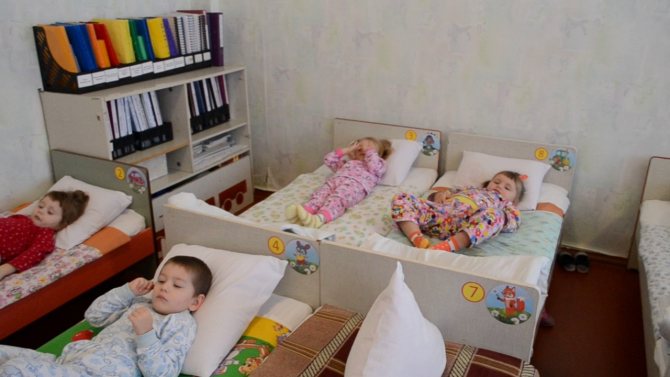
Children who wake up earlier should be occupied with exercises so that they do not wake up those who are still sleeping.
- Children should wear shorts and a T-shirt. If we are talking about the cold season, then pajamas. To perform exercises on the mat, you should wear shoes or socks.
- No coercion. If the little sun refuses to work together with everyone, then you absolutely cannot scold him. You just need to find out what caused this behavior.
- In the summer, a block of active exercises is recommended to be carried out outdoors.
- During the exercises, relaxation should be longer than tension.
- Instructions for implementation should be repeated more or less times depending on the emotional state of the kids.
Types and purposes of children's gymnastics
Exercises on the mat: “Walk” It’s frosty and windy outside, Children are walking in the yard. (Walk in place) Hands are warmed, hands are rubbed. So that our feet don’t get cold, we stomp a little.
Complexes of health-improving gymnastics after daytime sleep are compiled for two weeks. During this time, children manage to master the technique of performing individual health procedures. Thanks to the frequent change of complexes, children's interest in this gymnastics is maintained throughout the year.
I. p. – feet shoulder-width apart, hands below. 1.3 - arms up through the sides. Rise on your toes; 2.4 – i. P.
Methodology
If we summarize the above-mentioned features of the organization of corrective gymnastics, we can come to the conclusion that the optimal ratio would be a combination of 2-3 exercises in bed, 1-3 on the floor or on a rug and 2-3 breathing exercises performed to calm music (for example, sounds of nature or classics). In general, it will take 5–10 minutes to complete the gymnastics.
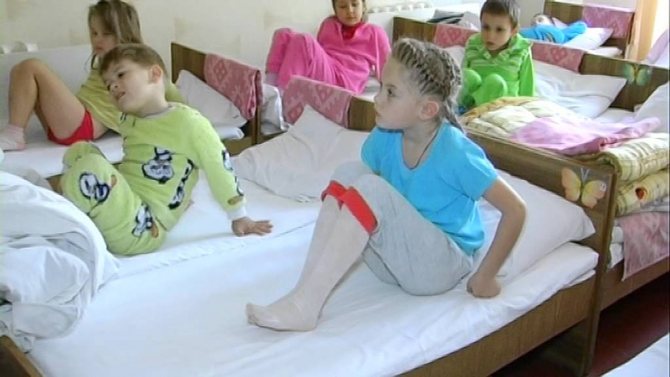
Spending 5-10 minutes after sleep helps maintain and improve children's health
Table: card index of exercises after sleep
| date | Exercise name | Description |
| September | Gymnastics in bed | |
| "Bike" | I. p.: lying on your back, “turn the pedals with the sound “w-w-w” (6 times) | |
| "Kitty" | I. p.: lying in the position of a sleeping cat, purr. The kitten kneels down and arches its back with the sound “sh-sh-sh” (6 times). | |
| "Hand massage" | I. p.: sitting, legs crossed. We wash our hands, rub our palms vigorously until a strong feeling of warmth is felt, apply pressure on each finger (6 times). | |
| Exercises on the mat | ||
| Children imitate movements in accordance with the text 3–4 times | I ask you to get up - that's one thing, Turning your head - that's two. Hands down, look forward - that's three. Hands to the sides - four, Press them firmly to the shoulders - five. All the guys sit down quietly - that's six. | |
| Walking along corrective and salt paths. | ||
| Breathing exercises | ||
| "Growl" | Growl for a long time as you exhale, baring your teeth, bending your tense fingers like claws. | |
| "Angry Dog" | Inhale sharply through the mouth, pronouncing “rr...”, with a simultaneous sharp blow of the hands overlapping the back (while standing, bending over). Exhale the same way through the nose. | |
| October | Gymnastics in bed | |
| "Stretch" | I. p.: lying on your back. We stretch our heels forward and both hands up (6 times). | |
| "Cheburashka" | I. p.: sitting cross-legged. We sculpt ears for Cheburashka, stroke the ears (“we apply clay” so that the ears do not come off (6 times). | |
| "Pinocchio" | I. p.: sitting on my knees, we sculpt a beautiful nose for Pinocchio. Pinocchio draws “sun”, “carrot”, “house” with his nose (6 times). | |
| Exercises on the mat | ||
| Children imitate the movements and repeat 3-4 times. | They jump and jump in the woods, Hares are gray balls, Jump - hop, jump - hop. The little bunny stood up on a stump, lined everyone up in order, and began showing exercises. Once - everyone walks in place. Two - they wave their hands together. Three sat down and stood up together. We reached four. Five - bent over and bent over. The six all stood in a row again, They walked like a detachment. | |
| Walking along corrective and salt paths. | ||
| Breathing exercises | ||
| "Penknife" | I. p.: lying on your back. As you exhale, bend your torso toward your legs, which do not lift off the floor. Pronounced while exhaling “Ha! " Repeat 3-4 times. | |
| "Pump" | I. p. - standing, hands in front of the chest, fingers clenched into fists. Leaning down with straight legs, exhale, saying [w]. As you straighten up, inhale through your nose. Repeat 6–8 times. | |
| “Who is better at inflating a toy?” | Inhale through the nose (1-4, exhale slowly through the mouth, into the hole of the toy (1-8). | |
| April | Gymnastics in bed | |
| "Delight" | I. p.: lying on your back. Stroking in the chest area with the words: “I am sweet, wonderful, beautiful.” (6 times). | |
| "Sipping" | I. p.: lying on your back. We pull the left leg with the heel forward, the right arm up along the body; pull the right leg with the heel forward, the left arm up, along the body (6 times). | |
| "Dough mixer" | I. p.: sitting cross-legged. The child strokes the belly clockwise, pats it with the edge of his palm, with his fist, strokes it again, pinches it, imitates the movements of a dough mixer kneading dough, strokes it again. (6 times) | |
| Exercises on the mat | ||
| Children imitate movements in accordance with the text 5–6 times | Here comes a black cat, (steps with legs raised high) Hidden - waiting for the mouse. (squats, hands to knees) The mouse will go around the mink, (stand up, turn around) And will not approach the cat (arms to the sides). | |
| Walking along corrective and salt paths. | ||
| Breathing exercises | ||
| "The nose is walking" | Inhale and exhale through the nose. Perform 10 – 20 times. | |
| "The nose is playing around" | When inhaling, press on the wings of the nose (prevent inhaling). Perform 10 – 20 times. | |
| “The nose smells pleasant smells” | Alternately close your nostrils with your fingers and take a deep breath. Perform 10 – 20 times. | |
| "The nose sings a song" | As you exhale, tap the wings of your nose and say ba, bo, bu. Perform 10 – 20 times. | |
This complex can be called universal, since it is aimed at preventing health problems. As for age characteristics, the differences will be in the frequency of execution and the number of exercises. So, for the first younger group, the “Exercises in bed” block remains unchanged, but the second and third blocks can be shortened.
Visibility for gymnastics
As is known, in preschool children the visual-figurative perception of the world is in the lead. Completion of tasks should be accompanied by bright, appropriately sized:
- pictures;
- soft toys;
- slides;
- posters.
The leading position remains with the toy. The fact is that children perceive her as a friend, comrade, which means they are more willing to complete the task. For younger groups, such a character serves as a role model, and for older groups - a younger comrade who needs the help of older friends.
If it is possible to show the kids slides, for example, with the hero who came to wake them up today, then such a transition to wakefulness will be easy and healthy.
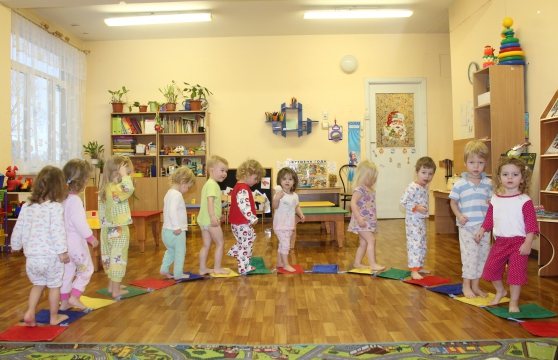
A massage mat can also be used as a visual aid: for example, if it is a forest path or a bridge over a river
Video: gymnastics after waking up (middle group)
Constantly keeping your body in good physical shape is much easier than constantly tormenting yourself with weight loss diets. Morning exercises or exercises are just for this purpose.
By doing morning exercises every day, you charge your body with energy and vigor for the whole day.
Morning exercises include a simple set of physical exercises that need to be performed after waking up.
When performing a set of morning exercises with a moderate load, try to use all the muscles of the body. In addition, there are simple exercises for the buttocks and legs that can be performed at home.
By devoting just a few minutes every morning to a set of physical exercises, you will raise your vitality and improve your health.
SIMPLE MORNING GYMNASTICS COMPLEX
Morning exercises (exercises) will help: activate metabolism, improve cardiac activity, strengthen and shape muscles, and help maintain correct posture. Thus, after morning exercises, the entire body as a whole and each organ in particular awakens.
If you have insomnia, indigestion, or apathy, then morning exercises can help cope with these problems. Morning exercises are useful for everyone, both preschool children and the elderly; it is especially recommended for office employees who lead a sedentary lifestyle.
MORNING GYMNASTICS - A COMPLEX OF SIMPLE EXERCISES
Morning exercises help women and men wake up faster and gain strength to confidently face a new day. You can start doing gymnastic exercises for girls without getting out of bed.
1. First, stretch, bending your whole body in different directions so that all the muscles tense. Inhale the air deeply and hold it, then exhale. Repeat this 5 times.
2. Now do hand squeezes. Do them vigorously 5 times. This exercise normalizes blood circulation.
3. Lying on your back, bend your knees. Hold them close to your chest and wrap your arms around them. Alternately bend and straighten your legs, bringing them to a straightened position, while creating counteraction with your hands. It will be more effective to breathe correctly. Perform 3 approaches.
4. Lower your legs from the bed while sitting, slowly rotate your head in a circle 5 times to the left, then change direction. Perform rotations with your eyes closed.
A universal set of exercises for morning exercises
Once you have developed the core muscles, you can begin more intense movements:
- Place your feet shoulder-width apart, raise your arms and lower them smoothly, accompanying this movement with a long exhalation. As you raise your arms, inhale as much as possible. Repeat 5 times;
- bend your elbows and grab your shoulders. Make vigorous circular movements forward, then backward 10 times;
- Bend your elbows and hold them in front of your chest, placing your palms on top of each other. Spread them 2 times to the sides, immediately in a bent state, then in an unbent state;
- Place your hands on your waist and smoothly rotate your body in a circle. Then bend your body back and forth, left and right. Do each exercise 7–10 times.
- standing with your feet shoulder-width apart, raise one arm up and rest the other on your side. Bend alternately left and right as much as possible, without bending your body forward. If your right arm is raised, then bend to the left, and vice versa;
- do squats with your arms raised. When squatting, swing your arms down, and when rising, raise your arms to the starting position. For optimal results, squat 10 times;
- Place your feet shoulder-width apart, stretch your arms in front of you, parallel to the floor, touch the toe of your right foot to your left palm and place it in the starting stance. Then touch the toe of your left foot to your right palm. Do these swings 5 times with each leg;
- Press your feet together and place your hands at a moderate height, palms down. We jog in place, try to touch your knees to your palms alternately.
It is advisable to perform this set of morning exercises for women and men in the given order, from top to bottom, so that the muscles are developed one by one.
If you have free time in the morning, you can supplement the set of morning exercises with strength techniques: pumping up your abs, doing push-ups. You can diversify your exercises by using a hula hoop (hoop), an expander, or dumbbells of various weights.
MORNING EXERCISES - GENERAL RECOMMENDATIONS
Doctors' recommendations for choosing a specific set of physical exercises for morning exercises for men, women, children and the elderly usually depend on age and gender.
For men, they advise including strength exercises, actively using dumbbells, expanders, rubber bandages, but not getting carried away with static tension.
Women are advised to focus on developing flexibility, strengthening the abdominal and pelvic floor muscles.
For older people, it is better to avoid strength exercises, as well as fast pace. It is better to give preference to breathing exercises and self-massage of the neck and head.
For children, doctors recommend general strengthening physical exercises that develop correct posture, as well as flexibility and coordination, and strengthen the muscles of the abdomen, neck, back, and arch of the foot.
Morning exercises for women and men should bring pleasure and a surge of vital energy. If you feel tired after doing morning exercises, you feel depressed and begin to feel short of breath, then it is better to simplify your morning exercise routine or take a break for a few days. Perhaps there is a reason to go to a training session at a sports and recreation center.
STRETCHING AFTER MORNING GYMNASTICS
A set of morning exercises should end with stretching. You can learn about what stretching is from the previous publication “Stretching is a set of exercises for the whole body.”
It is worth noting that these morning exercises will not help you do the splits or quickly build muscle. But, doing them regularly will help the body invigorate and recharge itself for the rest of the day for fitness.
The entire stretching program will take you no more than 5 minutes:
- Relaxation of the posterior surface of the pelvis. Lie on your back and clasp your relaxed leg with both hands. Forcefully pull it towards your chest as much as possible. As soon as you feel a pleasant burning sensation in the pelvic area, immediately stop the force on your lower limb and lock in this position for 30 seconds. The same movement is repeated with the other leg;
- Relieving neck fatigue after sleep. Without changing your position, bend your knees and clasp the back of your head with both hands. Begin to pull your head towards your chest, remembering to completely relax your neck. When you feel a slight burning sensation in the neck area, stop moving towards your chest and hold for 5 seconds. Repeat at least 5 times;
- Body stretching. This exercise is perfect for a comprehensive morning stretch. Try to relax as much as possible while lying on your back. Place your hands behind your head and begin to pull your limbs in opposite directions. You need to stretch for 20-30 seconds;
- Groin stretch. To make the exercise easier, you can take a pillow and place it behind your head. When lying down, you need to sit cross-legged. Try to relax your body and thoughts as much as possible. With the right attitude, your knees should move in different directions under their own weight. Completed within 1 minute;
- Forward bends are the final stretching exercise. Straighten up and bend down as low as possible, touching your fingers or palms to the floor. Fix yourself in this state for a few seconds. Every day, try to increase the duration of fixation in a bent position.
You can find out how to play sports during self-isolation here.
Scheme of analysis of gymnastics after sleep
To understand whether conducting exercises after sleep in a particular kindergarten group is effective, you need to evaluate each of the stages of its implementation according to the scheme. First you need to specify:
- name of the preschool institution and group;
- teacher's name;
- date;
- age of children;
- number of children in the group.
Table: sample analysis scheme
| No. | Gymnastics stage | List and description of exercises | Time frame | Conclusion (goals achieved or not) | Notes |
| 1 | Start of the climb, toilet | 3 minutes | |||
| 2 | Exercises in bed | ||||
| 3 | Exercises on the mat | 4 minutes | |||
| 4 | Breathing exercises | 3 minutes | |||
Gymnastics after sleep is very important for children. After all, with its help, kids not only restore their tone, but also learn to take care of their health. And maintaining and restoring the child’s normal well-being is one of the main tasks of his stay in a preschool educational institution.
Presentation - Gymnastics for waking up after a nap
IP: lying on your back, hands resting on your elbows, bend over, lift your chest up, keep your head straight (3-5 sec.), return to IP.
Card file of play stretching exercises Play stretching is specially selected muscle stretching exercises performed with children in a playful way.
They sleep quietly back to back and purr in their sleep: Murmur,murmur! .murmurmur! (Turn on their backs and do rotational exercises with their arms and legs) Everyone lies down on their back. Murmur,murmur! Raise your leg bent at the knee, straighten it down, keeping your leg suspended - press on an imaginary pedal. Lower your leg.
Regarding the age of preschoolers, the differences consist not only in the charging time, but also in the frequency of execution and the number of exercises. So, for the nursery group, the “Exercise in bed” block does not change, but other blocks can be omitted or made shorter.
Summary of gymnastics for waking up after a nap in the first junior group Objectives: 1. Gradually include children in active activities, moving from a state of inhibition to wakefulness. 2. Create positive feelings in children.
Note! Preschool children are recommended to perform special exercises while standing near a vertical plane. Therefore, many educators prefer to do exercises with children after sleep near their cribs.
CARD FILE OF GYMNASTICS EXERCISES AFTER NAP FOR PRESCHOOL CHILDREN, the complexes are described in detail and the material is structured by month of the school year and by age of the children. The proposed complexes can be used independently, or in a system. Most of them are plot-based.
